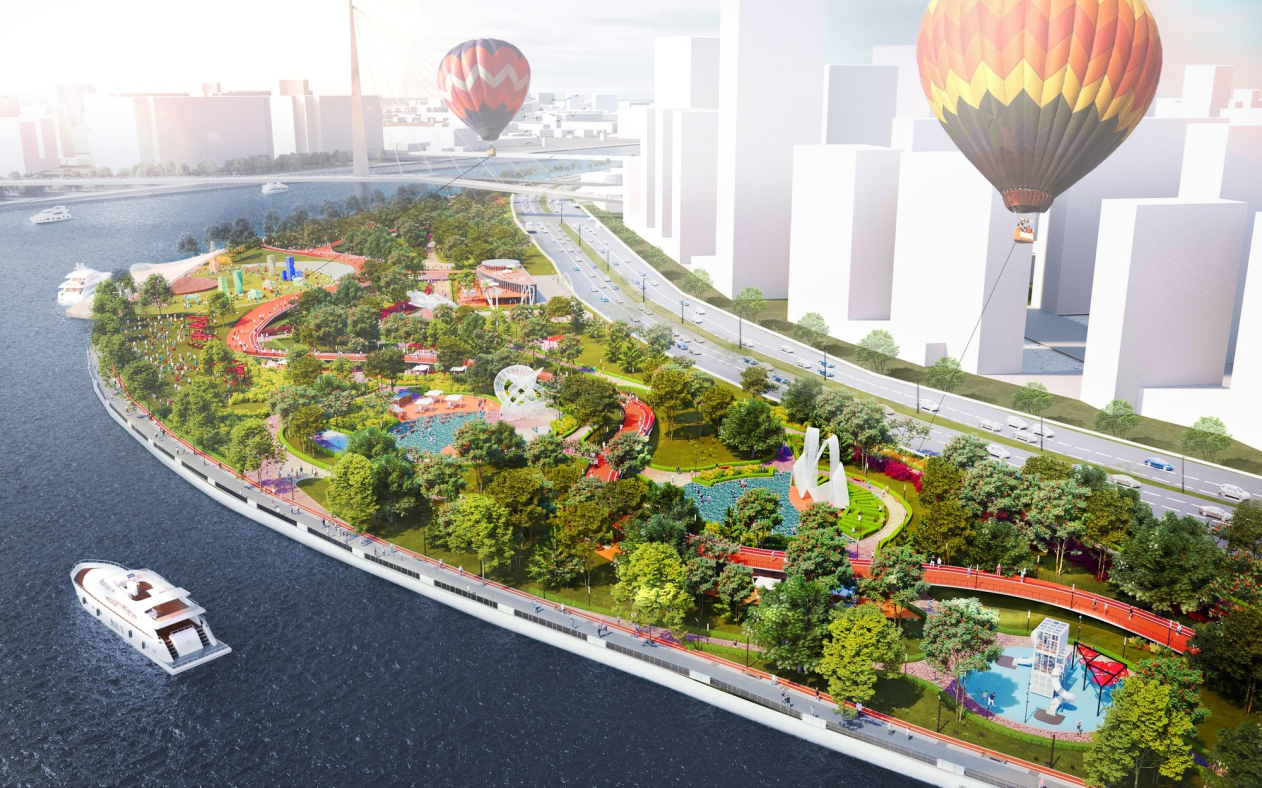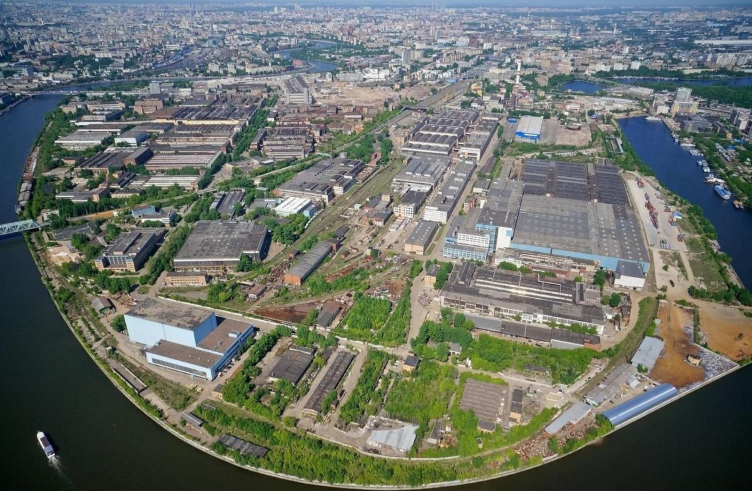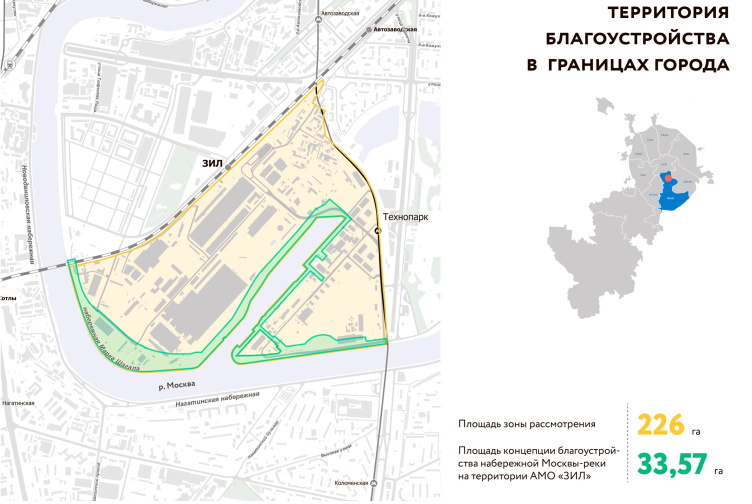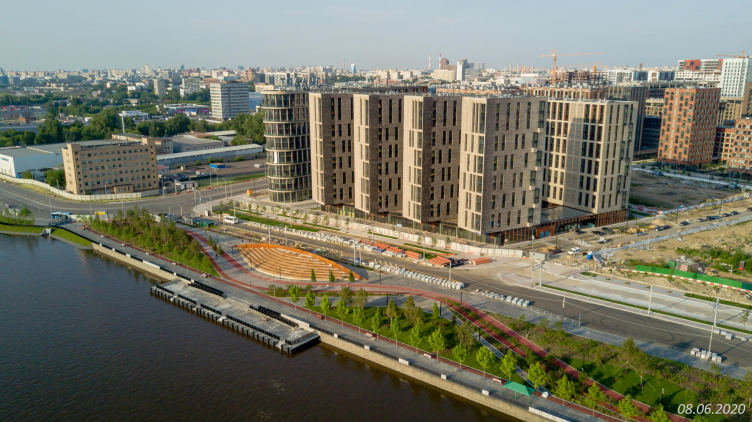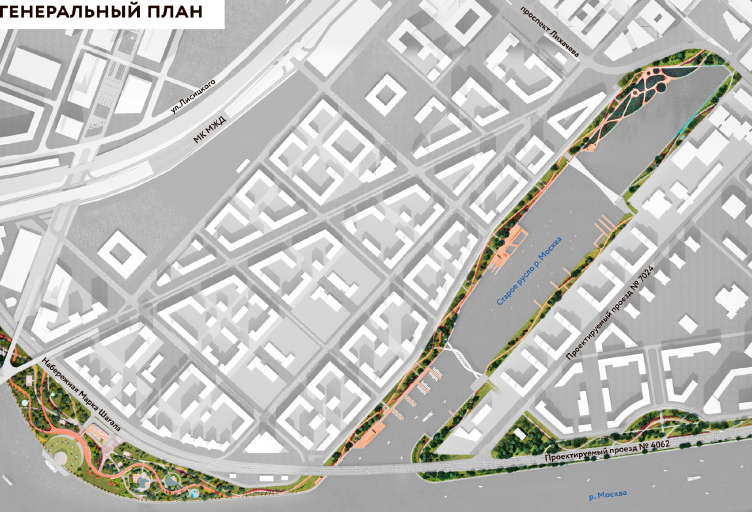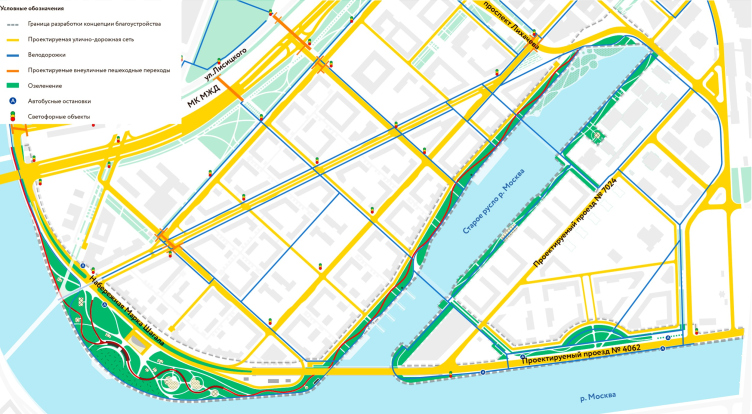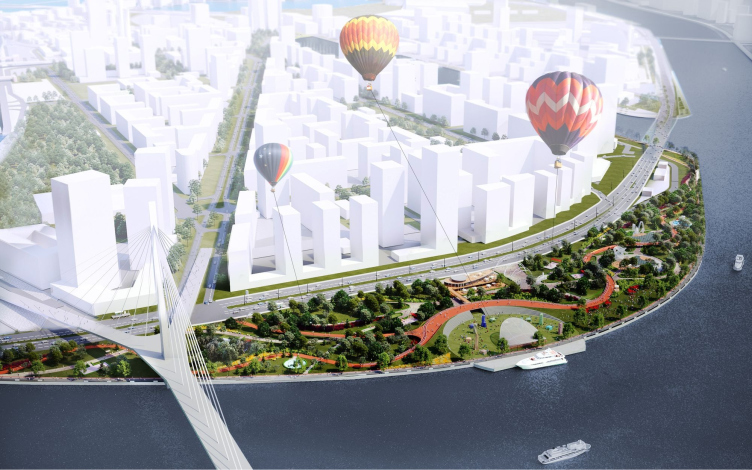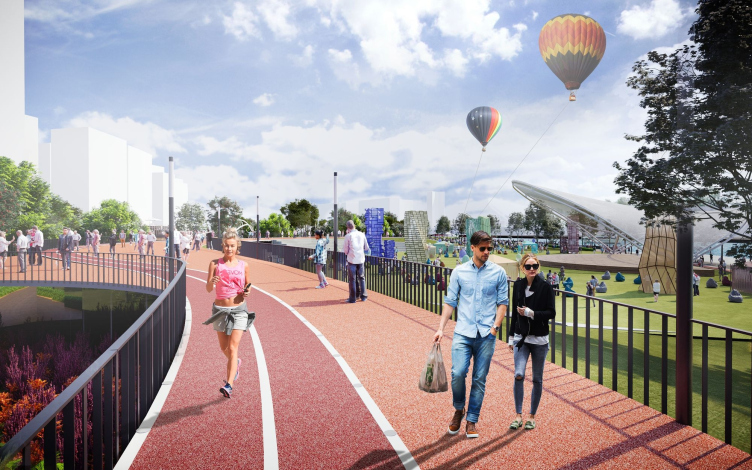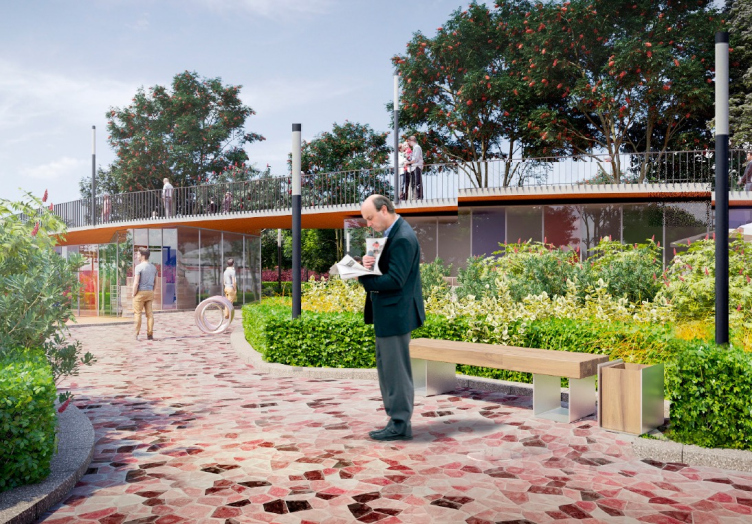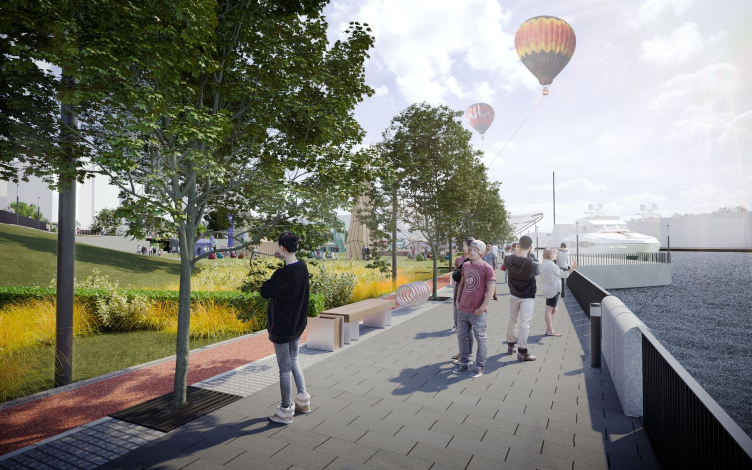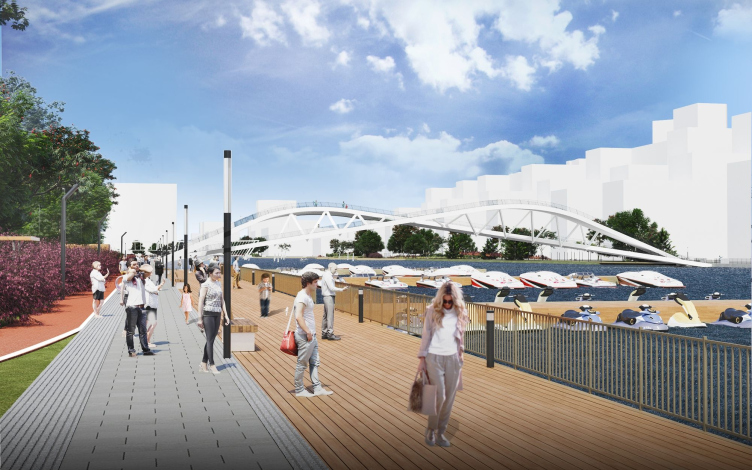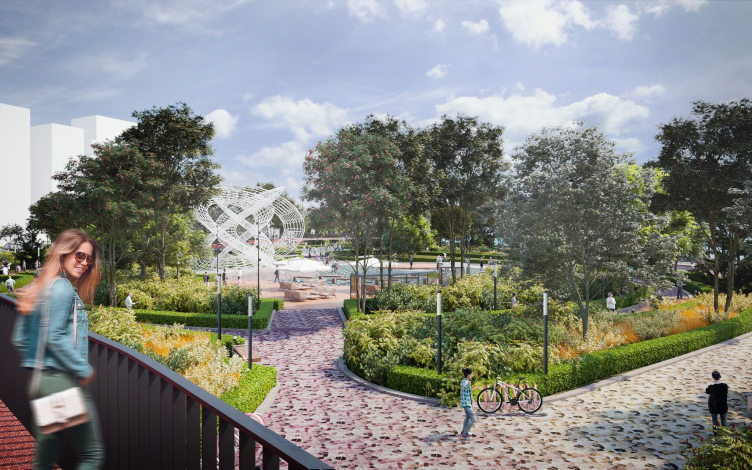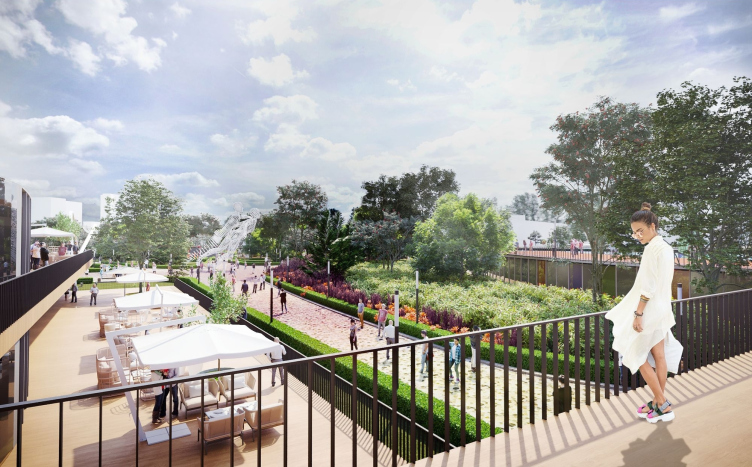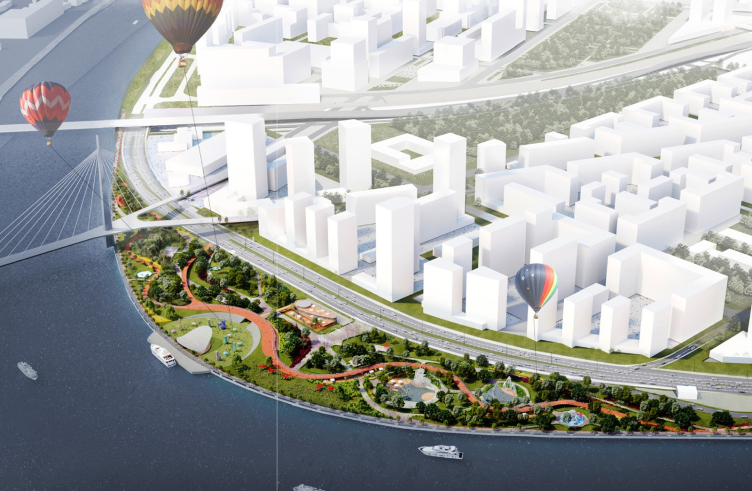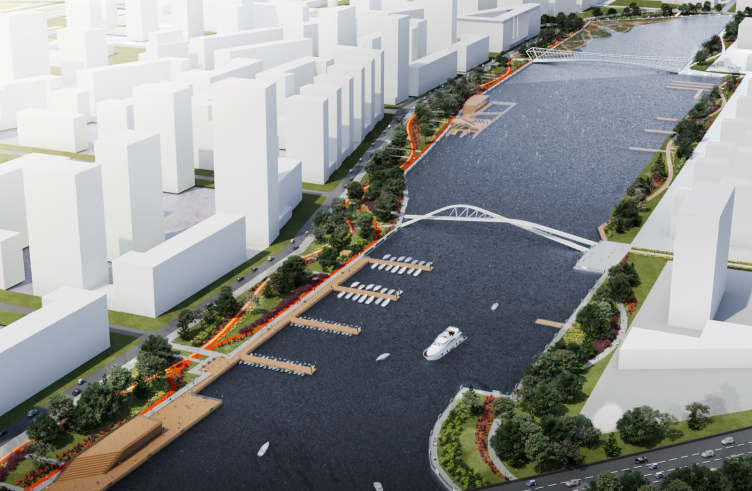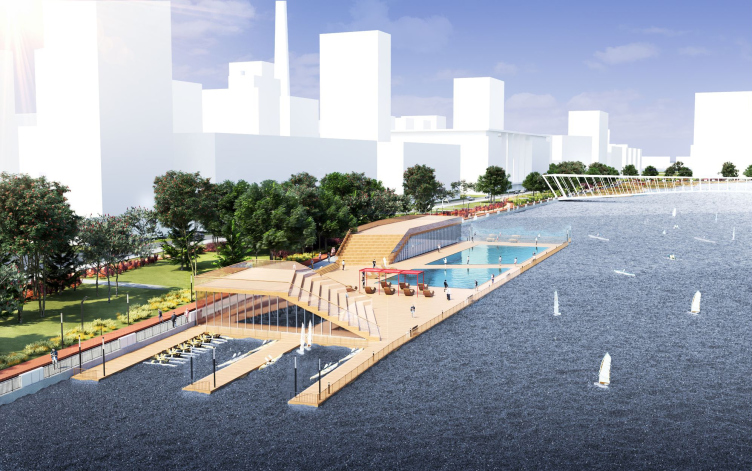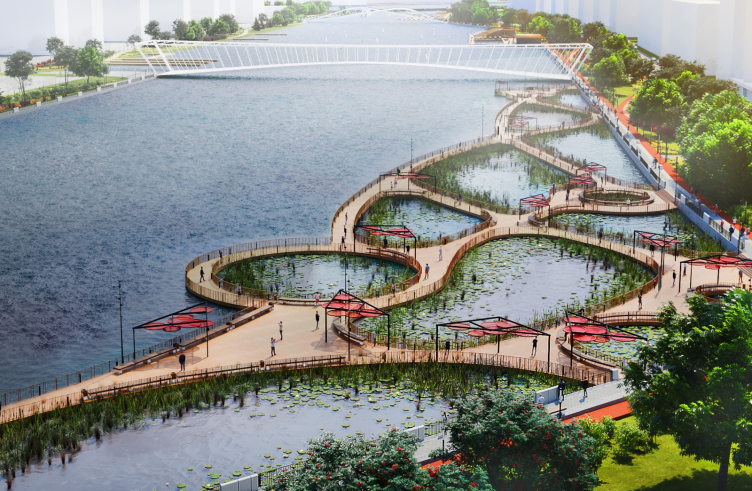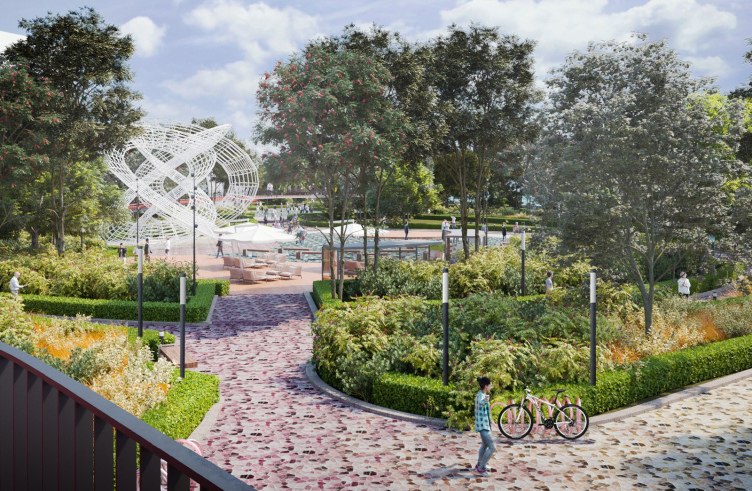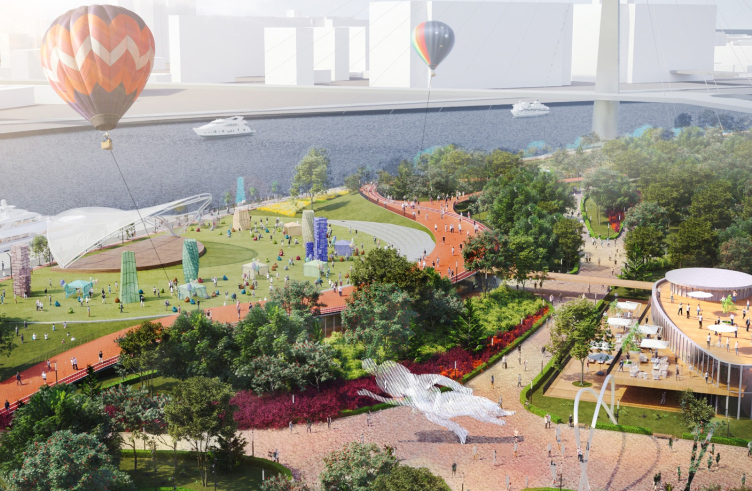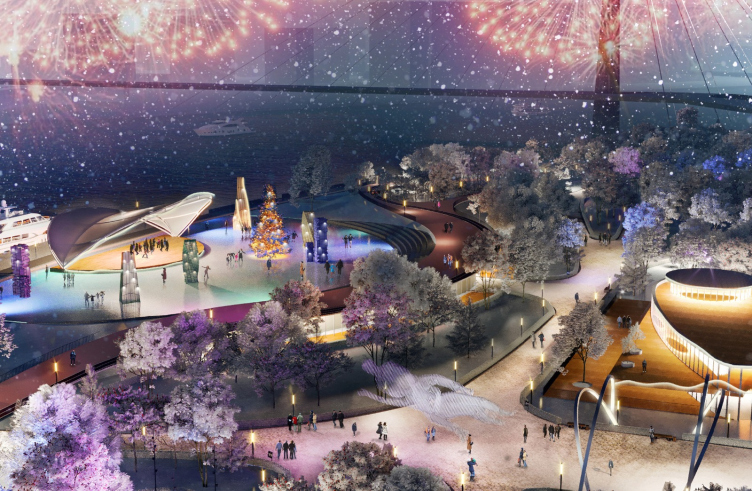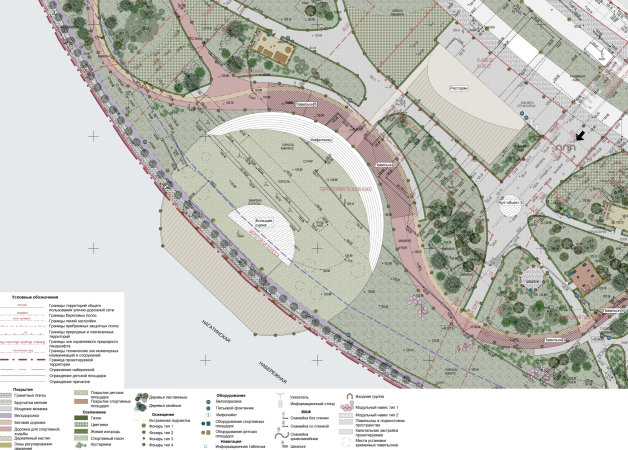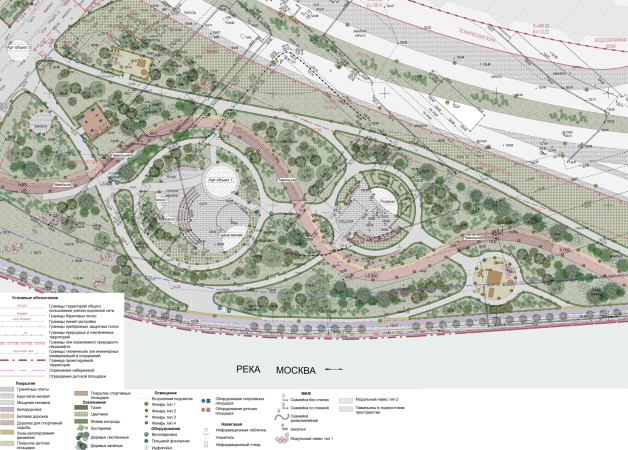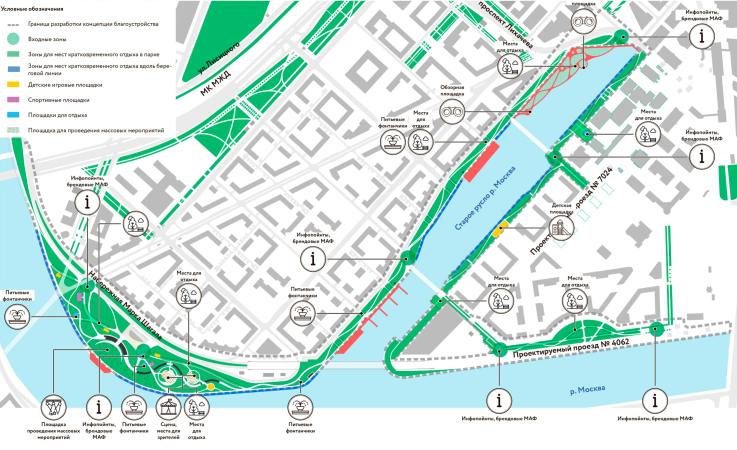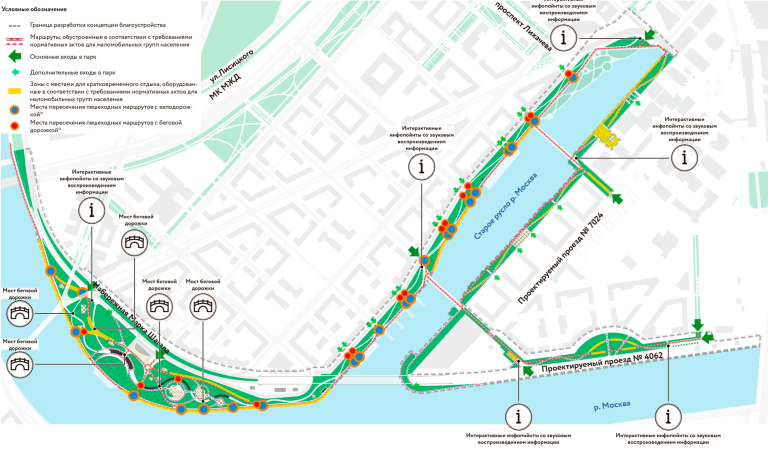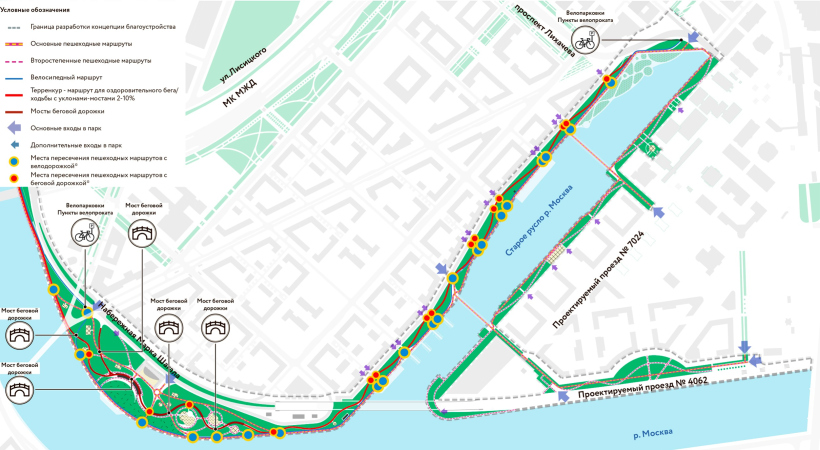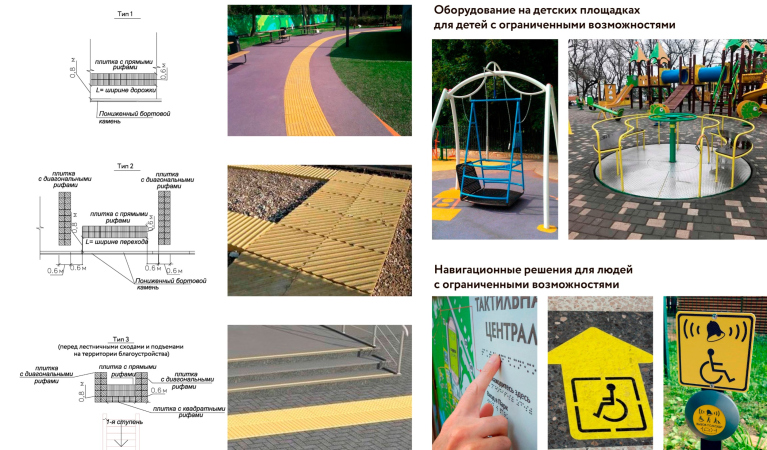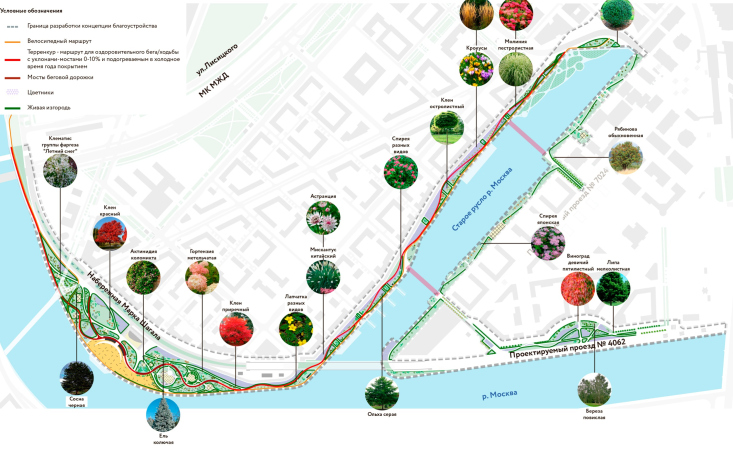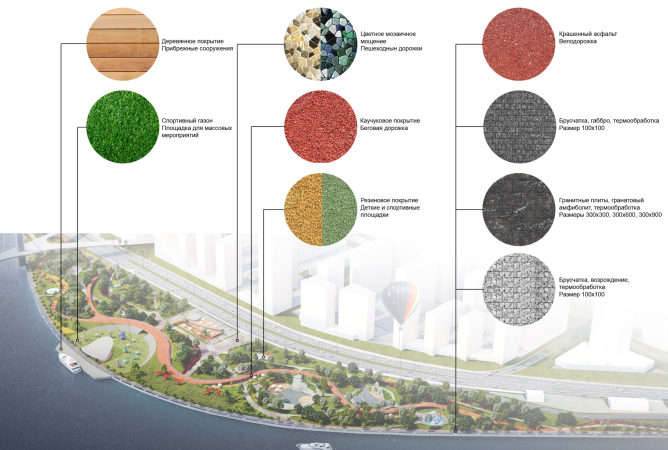We will remind you here that still back in 2011 Moscow City Architecture Committee initiated two large-scale projects of municipal importance, one of them being renovation of industrial parks, the other being development of the territories lying along the Moskva River. The reconstruction of the Marc Chagall Embankment refers to both narratives because ZIL is Moscow’s largest industrial park standing on the river. Improving this territory, and, further, taking these river banks to a new level plays an important part in this project.
The Marc Chagall Embankment
Copyright: © ASADOV Architects, Institute of the Master Plan of Moscow / provided by the press service of Moscow City Architecture Committee
The Marc Chagall Embankment and the territory of the former ZIL plant before the reconstruction
Copyright: © ASADOV Architects, Institute of the Master Plan of Moscow / provided by the press service of Moscow City Architecture Committee
As the Moscow City Architecture Committee website reports, in the next five years all the waterfronts in the ZIL area will be reconstructed – from the Novospassky Bridge to the Nagatinskaya Poima. This is almost 15 kilometers of riverbank land. More than half of them – 7.5 kilometers – is the Marc Chagall Embankment. It starts from the Third Transport Ring, and, describing a loop in the Novinka Backwater, which is essentially a fragment of the old riverbed of the Moskva River, finally stops at the Andropova Avenue.
The Marc Chagall Embankment
Copyright: © ASADOV Architects, Institute of the Master Plan of Moscow
The first stage
The first fragment of the embankment one kilometer long has already been completed. Here, on the fragment of the Likhacheva Avenue up to the Danilovsky Bridge, adjoining ZILART, appeared new jogging and cycling trails, pavilions looking like green hills, playgrounds and sports fields, as well as a moor with an amphitheater made of weathering steel, designed by Meganom.
The ZIL moor
Copyright: © ASADOV Architects, Institute of the Master Plan of Moscow
What comes next is the rest of the riverbank strip of the Moskva River and the rest of the land around the Novinka backwater.
The Marc Chagall Embankment. The master plan
Copyright: © ASADOV Architects, Institute of the Master Plan of Moscow
The second stage: a large embankment
Connected to the city
When the automotive plant was still functioning, the access to the water on its grounds was closed. Therefore, the architects saw their main task in returning the river to the city by means of creating an open and transparent space and restoring the lost visual and pedestrian connections. The web of new routes will form a single framework that will connect the riverside park to the construction of the new area and its infrastructure.
The park area is separated from the in-construction city blocks by a wide automobile road. However, thanks to a network of overpasses and underpasses, and the construction of a new road junction, the streets and boulevards of ZILART will literally flow into the park, continuing in pedestrian promenades and park trails. It is expected that the two banks of the old riverbed of the Moskva River will be connected by two pedestrian bridges and one automobile one, which will allow the motorists to drive through without having to circle the backwater area.
Along the contour of the Novinka, the park stretches in a narrow strip.

Vitaliy Luts, head of the agency for perspective projects of the Institute of the Master Plan of Moscow:
“The construction, which also includes service infrastructure projects, comes close to the water in such a way that the landscaped embankment will be best described as not so much a “park” as an “active urban space” that comes in close contact with water. In this respect, we drew inspiration from Hamburg’s Hafencity backwater, as well as the best practices of the North American cities – by Moscow standards, this approach is quite new.”
The Marc Chagall Embankment
Copyright: © ASADOV Architects, Institute of the Master Plan of Moscow
The Marc Chagall Embankment. Top view
Copyright: © ASADOV Architects, Institute of the Master Plan of Moscow
The routes
Originally, the concept of developing the riverside lands, developed by the team of Yuri Grigoryan, interpreted them as a multilevel compound space consisting of four “layers”, each one with a scenario and a unique name of its own. “Magnets”, the centers of attraction for the visitors: restaurants, cafes, and event venues. “Sport”, cycling and jogging trails. “Recreation”, promenades, gardens, and relaxation areas. “The promenade” – a long pedestrian route running at the water’s edge. The already landscaped fragment of the Marc Chagall Embankment vividly demonstrates how this concept can be implemented.
The project of the second stage is based on a slightly different approach, but the basic underlying idea is the same, and the four layers are also there. Andrey Asadov shared that the new land site will be designed in accordance with the common design code and the principles that constituted the original concept.
Andrey Asadov
We tried to develop the ideas proposed by Yuri Grigoryan, and embellish on them, drawing inspiration from the avant-garde artists. This is how we got the red bridge and sculptural compositions in the spirit of Russian avant-garde.
Many of Marc Chagall paintings are dominated by red and green. It was these paintings that the architects used as the basis for their project: the green riverside strip with gardens and promenades and the red stitch of the jogging trail, together with the red bridge. This is the fixed element of the concept, the central route that runs through the embankment from end to end. Sometimes it goes up, covering the park pavilions, and sometimes it goes down to the ground level, snaking and branching amidst the trees. The bridge will create a feeling of a multilayered space with “active” terrain. Some of its parts are designed as sightseeing platforms that command views of the river, part of the designed embankment, and the opposite bank. The bright color will be created by using special rubber coating.
The Marc Chagall Embankment. The red bridge and the jogging trail
Copyright: © ASADOV Architects, Institute of the Master Plan of Moscow / provided by the press service of Moscow City Architecture Committee
The sports agenda will be completed by bicycle trails, isolated from the pedestrians by special shrubbery. These will become a part of the city’s overall infrastructure, and a continuation of the bicycle route that stretches along the Moskva River for kilometers. Also, the embankment will get playgrounds, sports facilities, and sports gear rental points.
The Marc Chagall Embankment. The bridge covers the park pavilions
Copyright: © ASADOV Architects, Institute of the Master Plan of Moscow / provided by the press service of Moscow City Architecture Committee
The Marc Chagall Embankment. The promenade along the edge of thhe water
Copyright: © ASADOV Architects, Institute of the Master Plan of Moscow / provided by the press service of Moscow City Architecture Committee
The promenade designed for long and meditative walks runs immediately alongside the river. Already now one can imagine what the whole thing will look like: a river on one side and trees on the other, giving plenty of shade on a warm day, and comfortable benches commanding river views in their shadows. The best thing, though, is the opportunity to get right down to the water. For this, the architects designed a network of boardwalks made virtually on a level with the water, which blurs the border between the land and the water.
The Marc Chagall Embankment. The pedestrian promenade
Copyright: © ASADOV Architects, Institute of the Master Plan of Moscow / provided by the press service of Moscow City Architecture Committee
The Marc Chagall Embankment
Copyright: © ASADOV Architects, Institute of the Master Plan of Moscow
The “recreational” route will be designed as a park alley between landscape composition and sculptural pavilions. The elongated space of the park is divided into a multitude of theme zones – these are playgrounds, expo areas, small shops, and restaurants. All of them, light and neutral, will be integrated with the landscape.
The Marc Chagall Embankment. The park pavilions – light nad neutral
Copyright: © ASADOV Architects, Institute of the Master Plan of Moscow / provided by the press service of Moscow City Architecture Committee
The plaza and the moor
Each “layer”, like a band, is entwined in the park space. The nucleus of the composition, however, is the central plaza with a stage and a restaurant. The architects are planning to build it in the widest place on the bank, where the river makes a bend. The plaza, circular on the plan, is outlined by a large open-air amphitheater facing the water and the moor. The amphitheater is expected to host up to 4 thousand people. During the non-concert time, its visitors, sitting on the stairs, will be able to admire the panorama of the Moskva River and the opposite bank, as well as watching the river boats sailing away from the moor.
The Marc Chagall Embankment. The circular plaza with an amphitheater and thhe moor
Copyright: © ASADOV Architects, Institute of the Master Plan of Moscow / provided by the press service of Moscow City Architecture Committee
The moor will become a part of the nation’s capital infrastructure. It is expected that alongside with the improvement of the embankments the city will also liven up the river as one of its full-fledged transportation thoroughfares. The routes and the schedule of the river craft are currently being developed.
The Marc Chagall Embankment. The Novinka Backwater
Copyright: © ASADOV Architects, Institute of the Master Plan of Moscow / provided by the press service of Moscow City Architecture Committee
The river
The “river” expansion is not limited to building a moor and pontoons floating alongside the broad promenade. One must note that Asadov Architects has the experience of designing on water. Still in 2009, when the landscaping of the embankments seemed to be no more than a vague prospect, the company took part in the competition for floating structures on the Moskva River. Back then, the architects came up with the project named “Plav-Bulvar” (“Floating Boulevard”). It consisted of a few pontoons, each one of them having a name of its own – plav-club, plav-garage, plav-spa, expo-plav. Ten years later, they proposed something similar for the Marc Chagall Embankment – this time without the floating garage, but with a spa center and water garden.
The Marc Chagall Embankment. The spa center with a swimming pool on the river
Copyright: © ASADOV Architects, Institute of the Master Plan of Moscow
The backwater is particularly actively developed. It is planned that the spa center will be built on the water next to its left bank. The whole construction with saunas, locker rooms, and swimming pools will be mounted on a large pontoon. The swimming pool will be an open-air one – so that from the bank it would look as though the visitors were swimming in the fenced part of the river. The water in the pool, however, will be kept clean and heated.
The Marc Chagall Embankment. The water garden
Copyright: © ASADOV Architects, Institute of the Master Plan of Moscow / provided by the press service of Moscow City Architecture Committee
One of the particularly interesting proposals in this project is the water garden. It will be organized in the very heart of the old riverbed of the Moskva. And, if everything goes to plan, this will become one of the most beautiful places of the nation’s capital: the bodies of water, flowing into one another, overgrown with water lilies and other decorative water and swamp plants; walking trails streaming between them, and cozy places for recreation and drinking fountains, where you could sit down and admire the beauty of the garden.
The Marc Chagall Embankment. The sculptural groups with a refernce to avant-garde
Copyright: © ASADOV Architects, Institute of the Master Plan of Moscow / provided by the press service of Moscow City Architecture Committee
We must note that there is already one such implemented project in the Moscow metropolitan area. This is the park of water plants in the Pushkino district, which has been up and running for years, serving as a living proof that breeding water plants in the Moscow region is quite possible.
Memories of Avant-Garde
The whole concept of renovating the embankment refers to avant-garde art, and, first of all, following the name of the embankment, to Marc Chagall paintings. The ZIL area has strong ties with constructivism and avant-garde; today, streets here are named after master artists of this style.

Anna Ivanova, the head of the design studio of the city environment of the Master Plan of Moscow:
“The Marc Chagall images and motifs were used by us when we were developing the brand of the embankment, and when we were developing the single style of designing the objects and minor architectural forms.”
These are a series of sculptural pavilions or art installations that will appear across the entire Terri of the park. It is expected that modern artists will also be invited to take part in creating them, who will propose their own vision of recognizable images of Russian avant-garde, such as the hovering figures from Chagall canvases.
Although small on the inside (from 10 to 50 sqm), yet still heated, the pavilions will be used as multipurpose expo spaces displaying the works by avant-garde masters.
The Marc Chagall Embankment. Sculptures inspired by Chagall
Copyright: © ASADOV Architects, Institute of the Master Plan of Moscow / provided by the press service of Moscow City Architecture Committee
The Marc Chagall Embankment. The park in the wintertime
Copyright: © ASADOV Architects, Institute of the Master Plan of Moscow / provided by the press service of Moscow City Architecture Committee
The Park
It is expected that almost half of the former ZIL territory will be made completely green. East of the ZILART apartments, there is already a large landscape park “Tyufeleva Roshcha, designed by Gerry van Eijk. Tyufeleva Roshcha accounts for 10 hectares of parkland. The waterfront will add to it another 33 hectares of landscaped green territory.
On the waterfront, they are already planting trees and shrubs of various heights and shapes, which, alternating, will produce an effect of “waves of green”. The plants for the waterfront park are selected in such a way as to make sure that it stays lush all year round. Therefore, there will be a lot of spruce and evergreen plants. Looking to maximize the impressions from the proximity of different plants, the authors specially select trees whose leaves turn different colors depending on the season.
***
The project of the Marc Chagall Embankment is waiting to be implemented. Currently, the architects are working on the details of the project; the traffic infrastructure is being further developed, as well as the landscape elements. However, the sheer scale and thoroughness of the project already show that the riverside park at the bend is standing every chance of becoming the new center of attraction, possibly capable of rivaling the Zaryadye Park in the heart of the nation’s capital.

